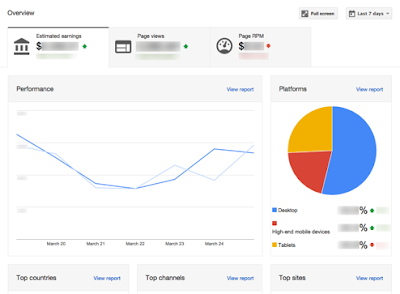2015 was a year with new and exciting AdSense updates. Let�s have a look at 2015 to recap all the product enhancements launched this year.
We�re looking forward to 2016 with lots of new features and formats to improve your AdSense experience.
As always, we�d like to thank you for sharing your feedback. Please keep sharing your thoughts and suggestions and stay tuned for more updates in 2016.
Happy New Year, and see you online in 2016!
Google AdSense Team
New features for your AdSense account:
- New sign-up flow: Signing up for AdSense is now faster and easier. Now, you have immediate access to your AdSense account once you sign up for AdSense.
- New AdSense website and mobile apps: We announced our new AdSense website with a new design and new publisher stories. We also updated the AdSense app with a fresh new look using material design and added some new features.
- New AdSense performance reports: To give you quick and easy access to these reports, we introduced a new design for AdSense reporting with a new dashboard. With the redesigned Performance reports tab, you now have more control and flexibility, allowing you to better understand your AdSense earnings and performance.
- Improved transparency in payments: We've received feedback from you that you want to know more about the differences between estimated and finalized earnings. Now, you�re able to see the invalid activity deductions that cause these differences.
- Matched content: To help you grow the number of pageviews on your site and increase user engagement, we launched Matched content. It�s a free content recommendation tool that promotes your content to your site visitors. Matched content generates contextually relevant and personalized article recommendations from the pages on your website. Have a look at the site management settings in your AdSense account to see if your sites are eligible to run Matched content.
- Certified Publishing Partner Program: We launched a new Certified Publishing Partner program to help you earn more from your sites while also saving you time.
New features for your ads:
- New mobile text ads: This new design allows for higher performance with a more beautiful and user-friendly appearance. The text ads feature elements such as a shaded background and a centered button which bring together the parts of the ad into a cohesive whole. To see these new mobile text ads, choose to show both text and display ads on your site, if you haven�t already done so.
- Richer text ads: Richer text ads are a new ad format that automatically creates image ads from text ads. They compete for both your text and display, and display-only ad units and could increase your earnings.
- Improved "Mute this ad" feature: With �Mute this ad,� users have a way to signal that they aren�t interested in certain ads. This feature gives users additional control over ad units. It also helps us find ad placements and creatives that users may not prefer so that we can continue working hard to serve better performing ads on your site.
We�re looking forward to 2016 with lots of new features and formats to improve your AdSense experience.
As always, we�d like to thank you for sharing your feedback. Please keep sharing your thoughts and suggestions and stay tuned for more updates in 2016.
Happy New Year, and see you online in 2016!
Google AdSense Team
 |
| Not yet an AdSense user? Sign up now! |






































